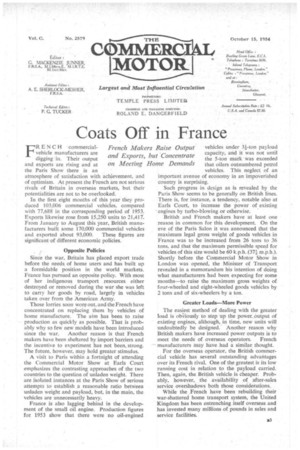Coats Off in France
Page 37

If you've noticed an error in this article please click here to report it so we can fix it.
FRENCH commercialvehicle manufacturers are digging in. Their output and exports are rising and at the Paris Show there is an atmosphere of satisfaction with achievement, and of optimism. At present the French are not serious rivals of Britain in overseas markets, but their potentialities are not to be overlooked.
In the first eight months of this year they produced 103,006 commercial vehicles, compared with 77,688 in the corresponding period of 1953. Exports likewise rose from 15,250 units to 21,417. From January to August this year, British manufacturers built some 170,000 commercial vehicles and exported about 93,000. These figures are significant of different economic policies.
Opposite Policies Since the war, Britain has placed export trade before the needs of home users and has built up a formidable position in the world markets. France has pursued an opposite policy. With most of her indigenous transport resources either destroyed or removed during the war she was left to carry her goods by road, largely in vehicles taken over from the American Army.
Those lorries soon wore out, and the French have concentrated on replacing them by vehicles of home manufacture. The aim has been to raise production as quickly as possible. That is probably why so few new models have been introduced since the war. Another reason is that French makers have been sheltered by import barriers and the incentive to experiment has not been. strong. The future, however, may hold greater stimulus.
A visit to Paris within a fortnight of attending the Commercial Motor Show at Earls Court emphasizes the contrasting approaches of the two countries to the question of unladen weight. There are isolated instances at the Paris Show of serious attempts to establish a reasonable ratio between unladen weight and payload, but, in the main, the vehicles are unnecessarily heavy.
France is also lagging behind in the development of the small oil engine. Production figures for 1953 show that there were no oil-engined vehicles under 3i-ton payload capacity, and it was not until the 5-ton mark was exceeded that oilers outnumbered petrol vehicles. This neglect of an important avenue of economy in an impoverished country is surprising.
Such progress in design as is revealed by the Paris Show seems to be generally on British lines. There is, for instance, a tendency, notable also at Earls Court, to increase the power of existing engines by turbo-blowing or otherwise.
British and French makers have at least one reason in common for this development. On the eve of the Paris Salon it was announced that the maximum legal gross weight of goods vehicles in France was to be increased from 26 tons to 36 tons, and that the maximum permissible speed for vehicles of this size would be 60 k.p.h. (371 m.p.h.). Shortly before the Commercial Motor Show in London was opened, the Minister of Transport revealed in a memorandum his intention of doing what manufacturers had been expecting for some months—to raise the maximum gross weights of four-wheeled and eight-wheeled goods vehicles by 2 tons and of six-wheelers by a ton.
Greater Loads—More Power The easiest method of dealing with the greater load is ob;-/ionsly to step -up the power output of existing engines, although, in time, new units will undoubtedly be designed. Another reason why British makers have increased power outputs is to meet the needs of overseas operators. French manufacturers may have, had a similar thought.
For the overseas operator, the British commercial vehicle has several outstanding advantages over its French rival. One of the greatest is its low running cost in relation to the payload carried. Then, again, the British vehicle is cheaper. Probably, however, the availability of after-sales service overshadows both those considerations.
While the .French have been rebuilding their war-shattered home transport system, the United Kingdom has been entrenching itself overseas and has invested many millions of pounds in sales and service facilities.




































































































